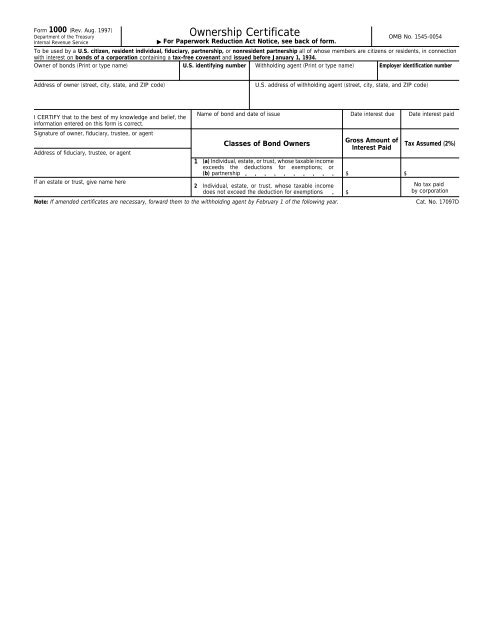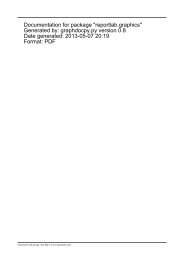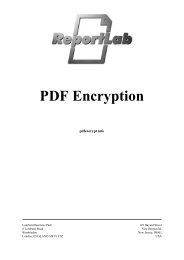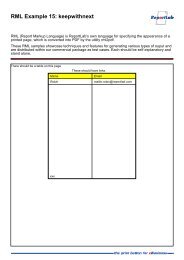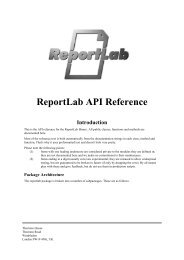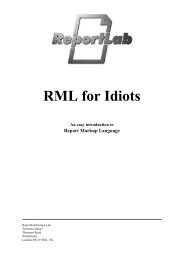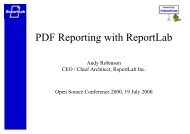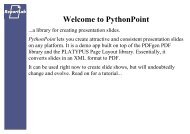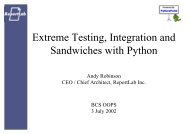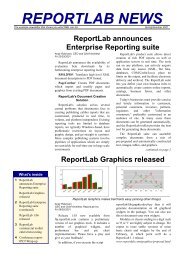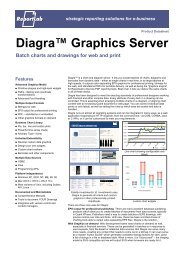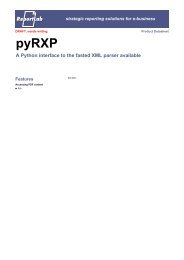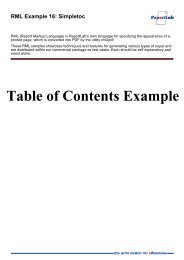Ownership Certificate - ReportLab
Ownership Certificate - ReportLab
Ownership Certificate - ReportLab
You also want an ePaper? Increase the reach of your titles
YUMPU automatically turns print PDFs into web optimized ePapers that Google loves.
Form 1000 (Rev. Aug. 1997)<br />
Department of the Treasury<br />
Internal Revenue Service<br />
<strong>Ownership</strong> <strong>Certificate</strong><br />
For Paperwork Reduction Act Notice, see back of form.<br />
OMB No. 1545-0054<br />
To be used by a U.S. citizen, resident individual, fiduciary, partnership, or nonresident partnership all of whose members are citizens or residents, in connection<br />
with interest on bonds of a corporation containing a tax-free covenant and issued before January 1, 1934.<br />
Owner of bonds (Print or type name)<br />
U.S. identifying number Withholding agent (Print or type name)<br />
Employer identification number<br />
Address of owner (street, city, state, and ZIP code)<br />
U.S. address of withholding agent (street, city, state, and ZIP code)<br />
I CERTIFY that to the best of my knowledge and belief, the<br />
information entered on this form is correct.<br />
Signature of owner, fiduciary, trustee, or agent<br />
Address of fiduciary, trustee, or agent<br />
1<br />
Name of bond and date of issue<br />
Classes of Bond Owners<br />
(a) Individual, estate, or trust, whose taxable income<br />
exceeds the deductions for exemptions; or<br />
(b) partnership<br />
If an estate or trust, give name here<br />
2 Individual, estate, or trust, whose taxable income<br />
does not exceed the deduction for exemptions<br />
Note: If amended certificates are necessary, forward them to the withholding agent by February 1 of the following year.<br />
Date interest due<br />
Gross Amount of<br />
Interest Paid<br />
$<br />
$<br />
Date interest paid<br />
Tax Assumed (2%)<br />
$<br />
No tax paid<br />
by corporation<br />
Cat. No. 17097D
Form 1000 (Rev. 8-97)<br />
Instructions to Owner, Fiduciary, Trustee,<br />
or Agent<br />
How To File. File this form with the withholding agent for<br />
interest payments on bonds that have a tax-free covenant and<br />
that were issued before 1934 by a domestic corporation or a<br />
resident or nonresident foreign corporation.<br />
Use a separate Form 1000 for each issue of bonds.<br />
Instructions to Withholding Agents<br />
Use Form 1042 to summarize Forms 1000. Do not send Form<br />
1000 to the Internal Revenue Service. Keep Form 1000 for at<br />
least 4 years after the end of the last calendar year in which the<br />
income the form applies to is paid.<br />
If a nonresident foreign corporation with a fiscal or paying<br />
agent in the United States issues the obligation, modify Form<br />
1000 to show the name and address of the nonresident debtor<br />
corporation in addition to the name and address of the U.S.<br />
fiscal or paying agent.<br />
Paperwork Reduction Act Notice. We ask for the information<br />
on this form to carry out the Internal Revenue laws of the United<br />
Page 2<br />
States. You are required to give us the information. We need it<br />
to ensure that you are complying with these laws and to allow<br />
us to figure and collect the right amount of tax.<br />
The time needed to complete and file this form will vary<br />
depending on individual circumstances. The estimated average<br />
time is 3 hours and 10 minutes.<br />
You are not required to provide the information requested on a<br />
form that is subject to the Paperwork Reduction Act unless the<br />
form displays a valid OMB control number. Books or records<br />
relating to a form or its instructions must be retained as long as<br />
their contents may become material in the administration of any<br />
Internal Revenue law. Generally, tax returns and return<br />
information are confidential, as required by Internal Revenue<br />
Code section 6103.<br />
If you have comments concerning the accuracy of this time<br />
estimate or suggestions for making this form simpler, we would<br />
be happy to hear from you. You can write to the Tax Forms<br />
Committee, Western Area Distribution Center, Rancho Cordova,<br />
CA 95743-0001. DO NOT send this form to this address.<br />
Instead, see How To File on this page.
THE EARLY 21ST CENTURY<br />
will be PROFOUNDLY CHANGED<br />
by the DIGITAL REVOLUTION.<br />
➥ Psion has a clear view of its role in the digital age. Psion focuses on<br />
mobile computing and data-communications. Psion’s key competence is<br />
innovation. Successful companies like Psion continuously innovate and<br />
adapt to their changing environment to create new business opportunities.
FINANCIAL HIGHLIGHTS<br />
For the Year Ended 31st December 1997<br />
In Thousands Except Per Share Amounts<br />
1997 1996<br />
Turnover £142,012 £124,178<br />
Gross Profit £50,804 £50,389<br />
Profit Before Tax £11,426 £16,036<br />
0.02<br />
0.03<br />
Profit After Tax £7,714 £10,353<br />
Earnings Per Share 10.30p 14.57p<br />
Dividends Per Share 2.50p 2.25p<br />
Research and Development Expenditure £10,934 £7,731<br />
TURNOVER In £ millions<br />
93<br />
94<br />
95<br />
96<br />
97<br />
£41.16<br />
£61.29<br />
£90.55<br />
£124.18<br />
£142.01<br />
PROFIT BEFORE TAX In £ millions<br />
93<br />
94<br />
95<br />
96<br />
97<br />
£3.03<br />
£6.55<br />
£11.65<br />
£11.43<br />
£16.04<br />
NET ASSETS In £ millions<br />
93<br />
94<br />
95<br />
96<br />
97<br />
£12.66<br />
£16.38<br />
£23.07<br />
£45.86<br />
£52.12<br />
Psion • Annual Report & Accounts 1997 • Proof 6 • 16/3/98
YOU PROBABLY KNOW PSION BEST AS<br />
A WORLD LEADER IN PALMTOP COMPUTING.<br />
BUT OUR BUSINESS IS MUCH BROADER.<br />
PSION SOFTWARE develops and<br />
licenses operating systems for mobile digital products.<br />
PSION INDUSTRIAL designs, manufactures and supplies<br />
mobile computers for commercial and industrial applications.<br />
PSION DACOM makes PC Card products. Psion Dacom<br />
leads Europe in this technology and is one of the<br />
top four PC Card manufacturers in the world.<br />
PSION<br />
COMPUTERS<br />
PSION<br />
INDUSTRIAL<br />
PSION<br />
DACOM<br />
PSION<br />
SOFTWARE<br />
United States<br />
Holland Germany United Kingdom<br />
YOU PROBABLY KNOW PSION AS A BRITISH<br />
COMPANY. BUT WE ARE A WORLDWIDE COMPANY.<br />
PSION has sales companies in the<br />
United States, in Holland, in Germany and in the UK.<br />
PSION has a worldwide distribution network which spans<br />
forty-five countries and five continents.<br />
Psion • Annual Report & Accounts 1997 • Proof 6 • 16/3/98
CHAIRMAN’S STATEMENT<br />
1997 was a year of great change both for Psion and the wider IT industry.After a weak performance in the first half<br />
of the year, the Company’s second half performance was much stronger. Psion benefited in particular from the high<br />
demand for the newly-launched Series 5.The Group’s increasing diversity will provide the robustness and strength<br />
the Group needs to compete in international markets.<br />
RESULTS OVERVIEW Profits in 1997 were held back by the strength of sterling which reduced sales by<br />
£12m and profits by £6m, and by the impact of major product introductions in our palmtop division. In addition,<br />
we increased our investment in research and development to £10.93m (1996 – £7.73m).<br />
Sales for the year were £142.01m, a rise of 14% over 1996 (£124.18m). Pre-tax profits were £11.43m<br />
(1996 – £16.04m).The Directors recommend a final dividend of 1.8p (1996 – 1.6p), making a total of 2.5p<br />
(1996 – 2.25p), a rise of 11% and covered four times by earnings.<br />
0.04<br />
0.05<br />
REVIEW OF OPERATIONS Psion’s four product companies, Psion Computers, Psion Industrial, Psion<br />
Dacom and Psion Software, have each made substantial progress during the year. Despite the problems created by the<br />
strength of sterling, our international markets have grown rapidly. For the first time, non-UK business accounts for<br />
the majority of Psion’s sales, both by value and by volume.This trend will continue, reflecting the global nature of<br />
our industry.<br />
Psion Computers successfully introduced the Series 5, the first Psion product based on 32-bit technology.The<br />
Series 5 won wide acclaim and found instant success in the marketplace. Since the launch Psion Computers has<br />
shipped more than 200,000 units, establishing the Series 5 as the clear market leader.<br />
Psion Dacom consolidated its position as Europe’s leading supplier of PC Card communication products.<br />
Moreover, with its recent agreement to supply Dell Computers worldwide, the company has the opportunity to<br />
become a world leader in its industry.<br />
Psion Industrial relocated to a new integrated office and manufacturing facility in Oxfordshire.With this new<br />
focus, the company has been successful in winning major contracts to supply mobile data-capture systems. Recent<br />
wins include London Underground in the UK, Mercedes in Germany, Finnair and the USA Today newspaper group<br />
in the United States.<br />
Psion Software has demonstrated its quality and depth in both systems and applications through the Series 5<br />
products.Two important third-party licensees were obtained in the year. Major third party licensing opportunities<br />
continue to arise, particularly in the emerging ‘smart-phone’ sector.<br />
➥ Building a group of companies focused on the emerging markets for MOBILE<br />
Psion • Annual Report & Accounts 1997 • Proof 6 • 16/3/98
DAVID POTTER Chairman 4th March 1998<br />
MANAGEMENT Psion operates in competitive global markets, succeeding through the endeavour and skills<br />
of its employees. On behalf of the Board, I would like to express our appreciation to all Psion personnel for their<br />
commitment and resourcefulness.<br />
We continue to work hard to broaden the experience on the Board and in senior management. During<br />
the year, Nicholas Myers was appointed to the position of Group Managing Director, with full operational<br />
responsibility for the Group. He has been well supported in this by the Managing Directors of the operating<br />
companies. I am also delighted to welcome Gareth Hughes as a main Board Director. Gareth has been Managing<br />
Director of Psion Dacom during the last three years and has led the outstanding growth and performance of<br />
that company.<br />
I am pleased to announce the nomination of Mr J. Barrie Morgans to the Board as a Non-Executive Director.<br />
Barrie is a previous Chairman, Chief Executive and Financial Director of IBM UK PLC and brings great experience<br />
to the Board. Last October, Peter Norman left the Group after serving on the Board of Psion for twelve years. During<br />
that period the Group grew more than thirty-fold and, on behalf of shareholders, I thank Peter for his significant<br />
contribution. In May of 1998, Sir Ian Morrow will retire from the Board after twelve years as the senior Non-<br />
Executive Director. Sir Ian’s contribution has been outstanding. I would like to thank him, both personally and<br />
on behalf of the Board, for his wisdom and friendship.<br />
DIGITAL INFORMATION PRODUCTS<br />
STRATEGY Over the years, Psion has built substantial assets in its brand, marketing, technology, international<br />
distribution and in developing mobile digital markets.We believe there will be a substantial expansion in the markets<br />
for general computer products and for dedicated information appliances such as organisers, cellular phones and digital<br />
audio products.<br />
Our strategy is to build a horizontal group of companies addressing mobile digital markets.At present we have<br />
four companies which focus on palmtop computers, data-communications, industrial terminals and embedded<br />
software applications and systems.Your Board intends to continue this process by expanding the Group through<br />
organic growth, strategic partnerships and by acquisition.<br />
OUTLOOK The opportunity is for growth in all our markets.We have expanded our position internationally and<br />
by market sector. In the data-communication and industrial businesses, new contracts will drive growth.We are well<br />
positioned with competitive products in the important and growing palmtop market.<br />
Given our growing markets, we continue to invest and plan for the longer term with confidence. However, with<br />
the continuing rapid change in palmtop markets, the Board remains cautious on the immediate outlook.<br />
Psion • Annual Report & Accounts 1997 • Proof 6 • 16/3/98
FINANCIAL REVIEW<br />
0.06<br />
0.07<br />
RESULTS Psion’s 1997 financial performance reflects a year of transition for the Group. Revenues increased<br />
by 14% to £142.01m (1996 – £124.18m) and the gross margin was 36% (1996 – 41%). Profits before tax were<br />
£11.43m, down from £16.04m in 1996.The results were affected by the introduction of a new generation of<br />
products based on 32-bit technology and by the strength of sterling. Investment in research and development was<br />
increased by 41% to £10.93m (1996 – £7.73).<br />
The Group’s trading performance in the middle part of the year was disrupted by retailers destocking ahead<br />
of the launch of the Series 5.The Series 5 was well received and in the last quarter of the year trading was strong<br />
in all markets.<br />
The strength of sterling adversely affected the Group’s profitability. On a constant currency basis, using the<br />
Group’s average exchange rates during 1996 and 1997, revenue growth would have been 24% rather than 14% and<br />
profit before tax approximately £6m higher than reported.<br />
Despite sterling’s strength, overseas sales exceeded 50% of revenues for the first time to reach 55% of Group<br />
revenues (1996 – 49%).The performance in Continental Europe was excellent with growth of 29% to £54.58m<br />
(1996 – £42.30m). Sales in North America recovered strongly from a weak first half and in the second half sales were<br />
53% ahead of the equivalent period in 1996.<br />
➥ Increasing research and development spend and record capital expenditure highlights<br />
1997 Year Actual Constant<br />
£ millions exchange rates Growth exchange rates Growth<br />
Turnover 142.01 +14% 154.40 +24%<br />
Profit before tax 11.43 -29% 17.50 +9%<br />
MARINA WYATT Financial Director 4th March 1998<br />
Psion • Annual Report & Accounts 1997 • Proof 6 • 16/3/98
Turnover by Destination 1997<br />
Research & Development Expenditure<br />
£ millions<br />
Continental<br />
Europe<br />
39%<br />
North America<br />
11%<br />
United Kingdom<br />
45%<br />
93<br />
94<br />
95<br />
96<br />
97<br />
£1.48<br />
£2.71<br />
£5.58<br />
£7.73<br />
Rest of World<br />
5%<br />
£10.93<br />
our commitment to INVESTING FOR THE FUTURE<br />
BALANCE SHEET, INVESTMENT AND CASH Net Assets were £52.12m at the end of the year (1996 –<br />
£45.86m). Cash generation in the second half was good with more than £10m generated from trading. Cash balances<br />
at year end were £22.40m (1996 – £26.47m) and the balance sheet is ungeared except for £0.91m of finance lease<br />
liabilities (1996 – £2.10m). During the year £10.37m (1996 – £8.86m) was invested in fixed assets, including a new<br />
manufacturing facility in Oxfordshire and additional surface mount assembly lines at each of Psion’s three factories.<br />
Expenditure on research and development increased by 41% to £10.93m (1996 – £7.73m), representing 7.7%<br />
of turnover (1996 – 6.2%).This investment is vital to Psion’s ability to innovate and grow. A significant element of this<br />
investment is currently being made in Psion Software’s development of software platforms and applications.<br />
TREASURY,TAX AND EPS Psion sells into overseas markets and the purchases of the majority of its<br />
components are affected by foreign exchange rates.The Group’s exposure to foreign exchange fluctuations is reduced<br />
because the Group both buys and sells in overseas markets. Nevertheless, as demonstrated above, sterling’s strength had<br />
a significant impact on 1997’s performance.The Board’s policy is to seek to minimise its foreign exchange risks<br />
through entering into forward exchange contracts.The results of overseas subsidiaries are translated at average<br />
exchange rates for the year.This translation exposure is not hedged as a matter of policy.<br />
The fall in the Group’s tax rate from 35.4% in 1996 to 32.5% in 1997 arose from the reduction in the UK<br />
corporation tax rate and the utilisation of overseas tax losses.<br />
Earnings per share were 10.30p for the year (1996 – 14.57p).We have proposed an increase in the final dividend<br />
to 1.8p, taking the total dividend for the year to 2.5p (1996 – 2.25p).The dividend is covered 4.1 times by earnings.<br />
ACCOUNTING POLICIES Accounting policies applied during the year were consistent with those applied in<br />
1996. During 1997 we introduced long term contract accounting to accommodate the third party licensee contracts<br />
entered into by Psion Software.This policy is explained in more detail on page 32 and resulted in long term contract<br />
revenues of £0.68m (1996 – £nil) being recorded in the year.<br />
OUTLOOK Psion enters 1998 in a good financial position from which to address the challenges and opportunities<br />
which lie ahead.<br />
Psion • Annual Report & Accounts 1997 • Proof 6 • 16/3/98
OPERATIONAL REVIEW<br />
OVERVIEW 1997 was the first full year in which Psion’s four product companies have been fully operational<br />
after the Group’s reorganisation in mid-1996. Each product company focuses on a specific market segment:<br />
Psion Computers on palmtop computers, Psion Industrial on handheld computers for industrial and commercial<br />
applications, Psion Dacom on mobile network products and Psion Software on operating systems and application<br />
software.All the companies made good progress towards developing greater focus on their respective markets.The new<br />
organisational structure will also help improve operational effectiveness, especially in supply chain management and<br />
distribution logistics.The operations of each product company are outlined in more detail in subsequent pages.<br />
0.08<br />
0.09<br />
TRADING REVIEW The key 1997 event for Psion Computers was the introduction of the Series 5, the first<br />
in a range of new palmtop computers based on 32-bit technology.The Series 5 was well received in all markets<br />
and demand was buoyant. However, the introduction of the Series 5 in June disrupted the distribution channels<br />
for Psion Computers’ existing products and significantly affected the company’s second and third quarter<br />
financial performance.<br />
➥ Psion companies market innovative products which integrate design and technological<br />
NICHOLAS MYERS Managing Director 4th March 1998<br />
Sales by Product Group 1997<br />
Palmtops<br />
64%<br />
Data-communications<br />
22%<br />
Industrial Terminals<br />
14%<br />
Psion • Annual Report & Accounts 1997 • Proof 6 • 16/3/98
excellence to MEET THE USER’S NEEDS<br />
Psion Dacom had a successful year with substantial growth in PC Card modem sales, up by 38%. Psion Dacom<br />
contributed 22% of Psion’s 1997 revenues, increasing from 18% in 1996. Psion Dacom’s business is increasingly<br />
international, a trend which will continue in 1998. In November 1997 Psion Dacom was appointed as a worldwide<br />
supplier of 56k PC Card modems to Dell Computers, the world’s third largest PC supplier.<br />
In the first half of 1997 Psion Industrial relocated and staffed a new integrated factory and office facility in<br />
Oxfordshire. Despite this disruption, sales were sustained at £19.32m (1996 – £19.64m). New additions to the range<br />
included Workabout models with integrated barcode readers and laser scanners.These extensions to the Workabout<br />
range have opened the growing automatic identification markets to the company for the first time.<br />
Psion Software has successfully licensed its EPOC32 platform to major multinational companies. In September<br />
1997, Philips was publicly announced as an EPOC32 licensee. Philips intend to use EPOC32 in a range of ‘smartphone’<br />
products. Smart-phones are mobile telephones with data capabilities such as e-mail, faxing, and web browsing.<br />
Announcements about further licensees will be made in due course. Future revenues from third party licensees<br />
depend on the timing of product introductions.<br />
RESEARCH AND DEVELOPMENT Psion’s long term success depends on the Group’s ability to deliver new<br />
and innovative products.To achieve this, each product company has its own research and development function. In<br />
1997, the Group expanded the resources dedicated to research and development. Significant resources were channelled<br />
to Psion Software to support the continuing development and customisation of EPOC32 for Group product<br />
companies and for new third party licensees. By the end of 1997 the number of research and development personnel<br />
in the Group had risen to some 270 people.<br />
MANUFACTURING During 1997 Psion increased its manufacturing capacity significantly. Psion Industrial’s<br />
new factory commenced production in the summer and new Surface Mount Assembly lines were added at<br />
Psion Computers and Psion Dacom, bringing the Group’s total capacity to six Surface Mount Assembly lines<br />
in three factories.<br />
1998 OUTLOOK During 1998 the product companies will continue to focus on their core markets by developing<br />
products and services that extend and enhance their product ranges. The increase in the depth and diversity of the<br />
Group’s business has strengthened its position ready for the challenges and opportunities which lie ahead.<br />
Psion • Annual Report & Accounts 1997 • Proof 6 • 16/3/98
PRODUCT COMPANY REVIEW<br />
Psion Computers<br />
0.10<br />
0.11<br />
1997 REVIEWED 1997 was a successful year for Psion Computers with over 400,000<br />
computers sold worldwide.With the launch of the Series 5 in June 1997, Psion Computers<br />
made the transition from 16-bit to a new generation of 32-bit technology.The Series 5 gives<br />
the mobile professional unprecedented computing power in a handheld form.While the<br />
Series 5 is independently effective, it readily connects to the PC and inter-operates with<br />
a wide range of PC applications.The Series 3 range, with over 1 million units shipped,<br />
continues to evolve as a value-line palmtop computer for consumer markets, whilst the Siena<br />
is marketed as a high end organiser.All Psion products share the qualities of innovative design,<br />
simplicity of use, fitness for purpose and charm.<br />
The Series 5 was an immediate success, reaping media accolades both for the<br />
excellence of its hardware design as well as for the depth and sophistication of its software.<br />
Early demand outstripped initial production volumes, although this position improved as<br />
volumes rose through the year. During the first half of 1997 the imminent introduction of<br />
Series 5 affected demand for the existing Series 3 and Siena products. During the second half<br />
of the year, sales recovered as the market recognised the Series 5 as a complementary<br />
extension of Psion’s existing product range rather than as a replacement for the Series 3.<br />
Despite the market turbulence caused by the first products based on Microsoft’s<br />
Windows CE, overseas sales were excellent. Encouragingly, sales into non-Psion company<br />
countries rose especially strongly, even in territories where the Series 5 was not available.<br />
In 1997, more than a third of Psion Computers’ sales were to these countries.<br />
1998 OUTLOOK Psion Computers enters 1998 with many opportunities in a growing<br />
market with a range of market-leading, competitively priced products which will continue<br />
to set the standard for handheld products.The Company will maintain and enhance its<br />
competitiveness through new product introductions, incremental improvements to the<br />
existing 32-bit and 16-bit product ranges, and a competitive pricing policy.<br />
CHARLES DAVIES Managing Director<br />
Psion • Annual Report & Accounts 1997 • Proof 6 • 16/3/98


